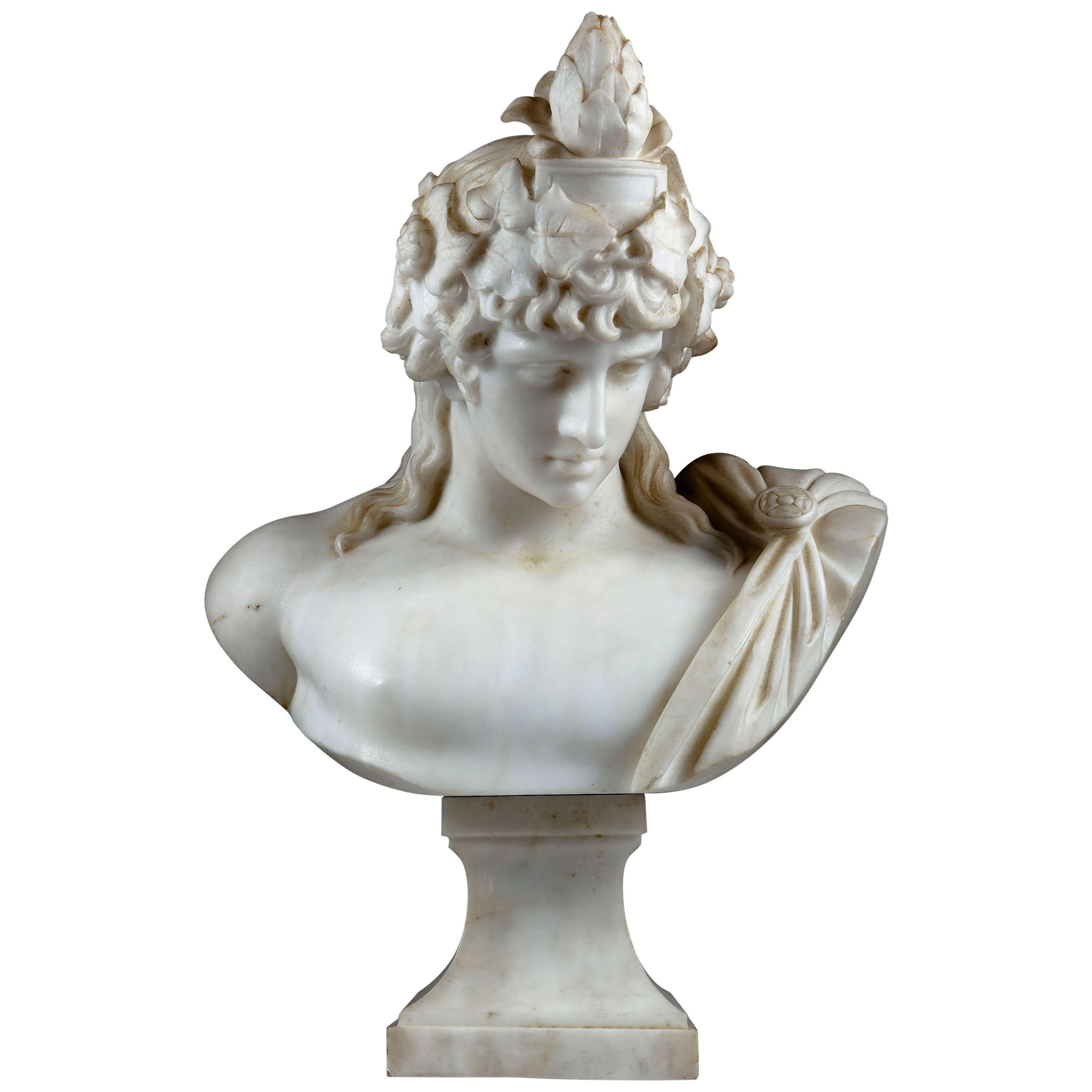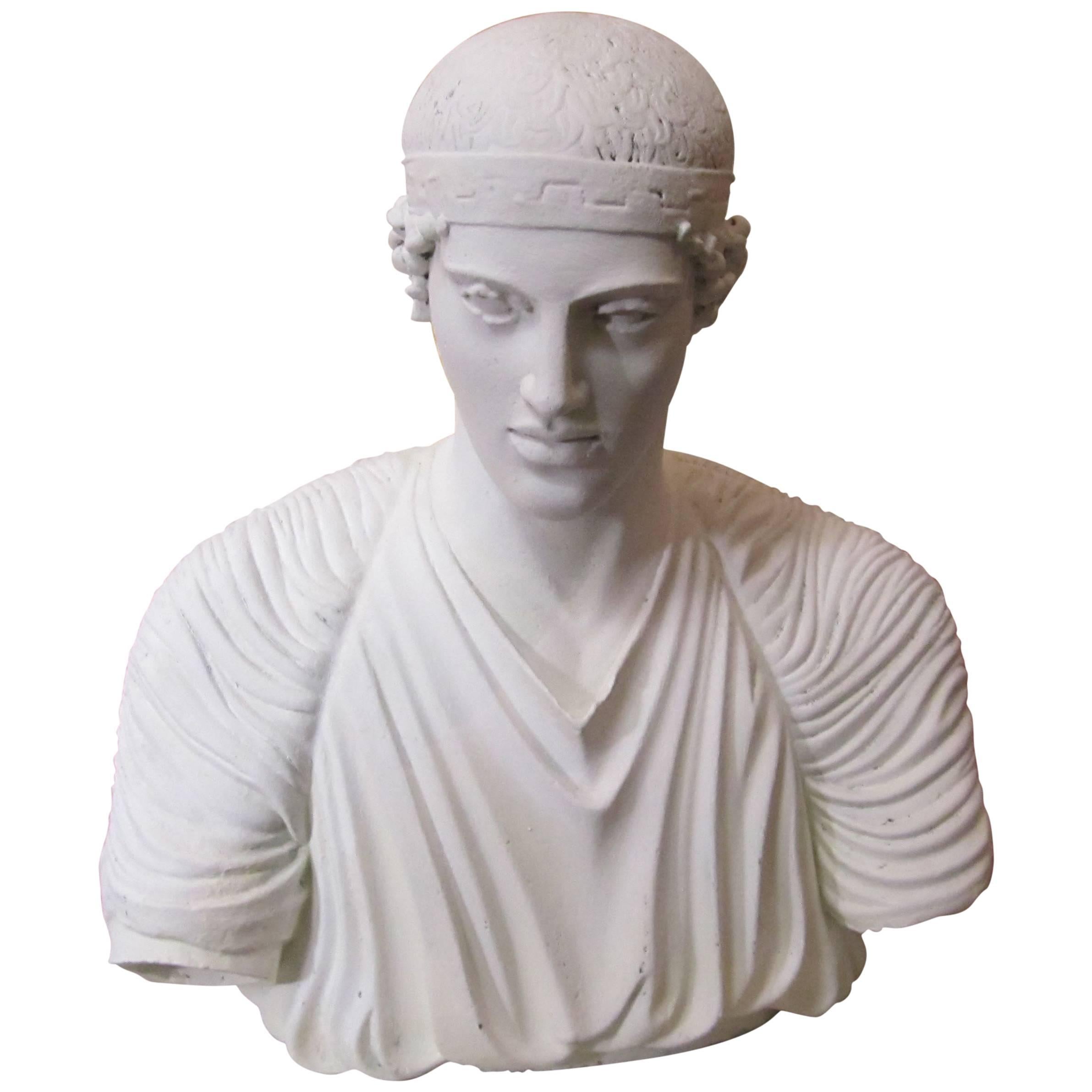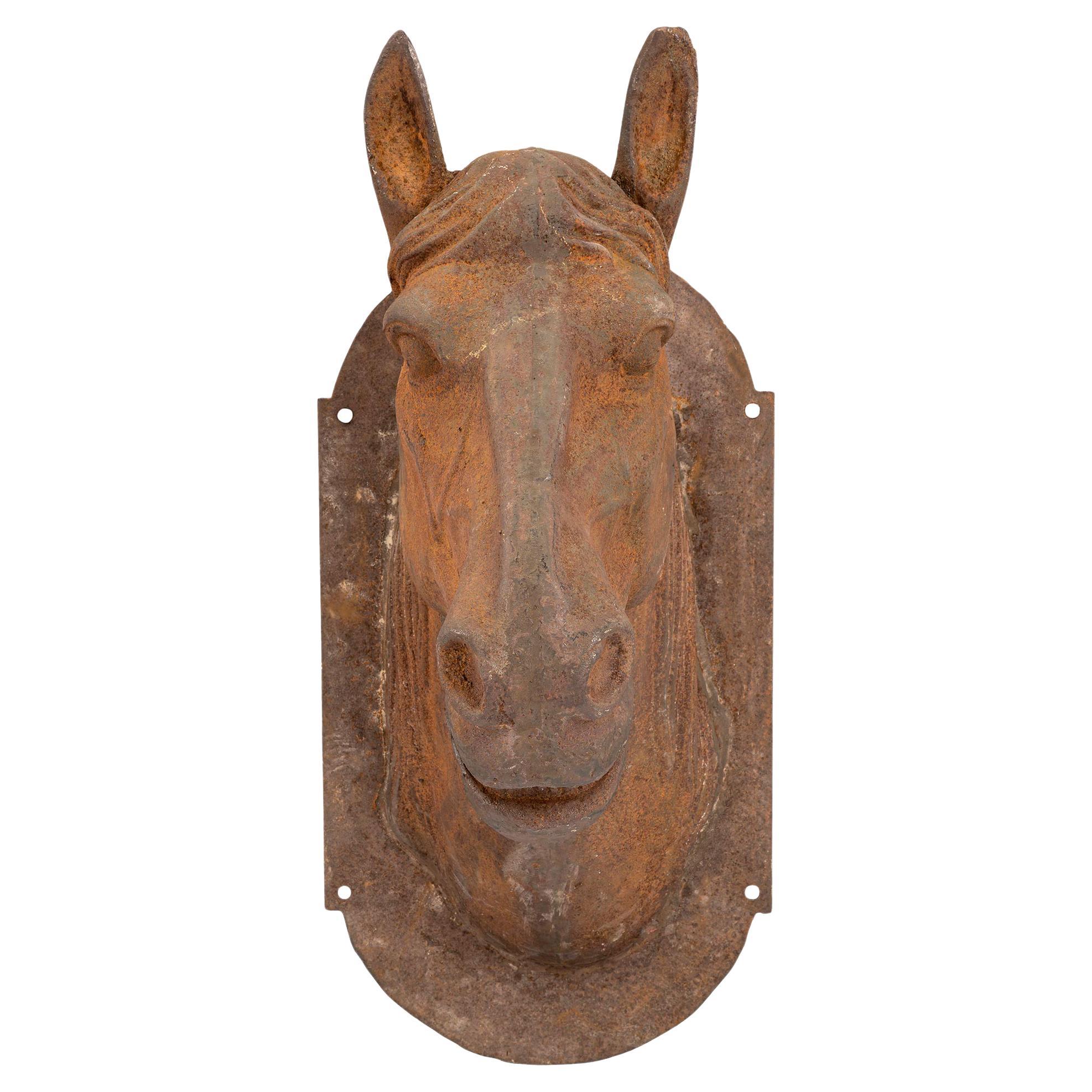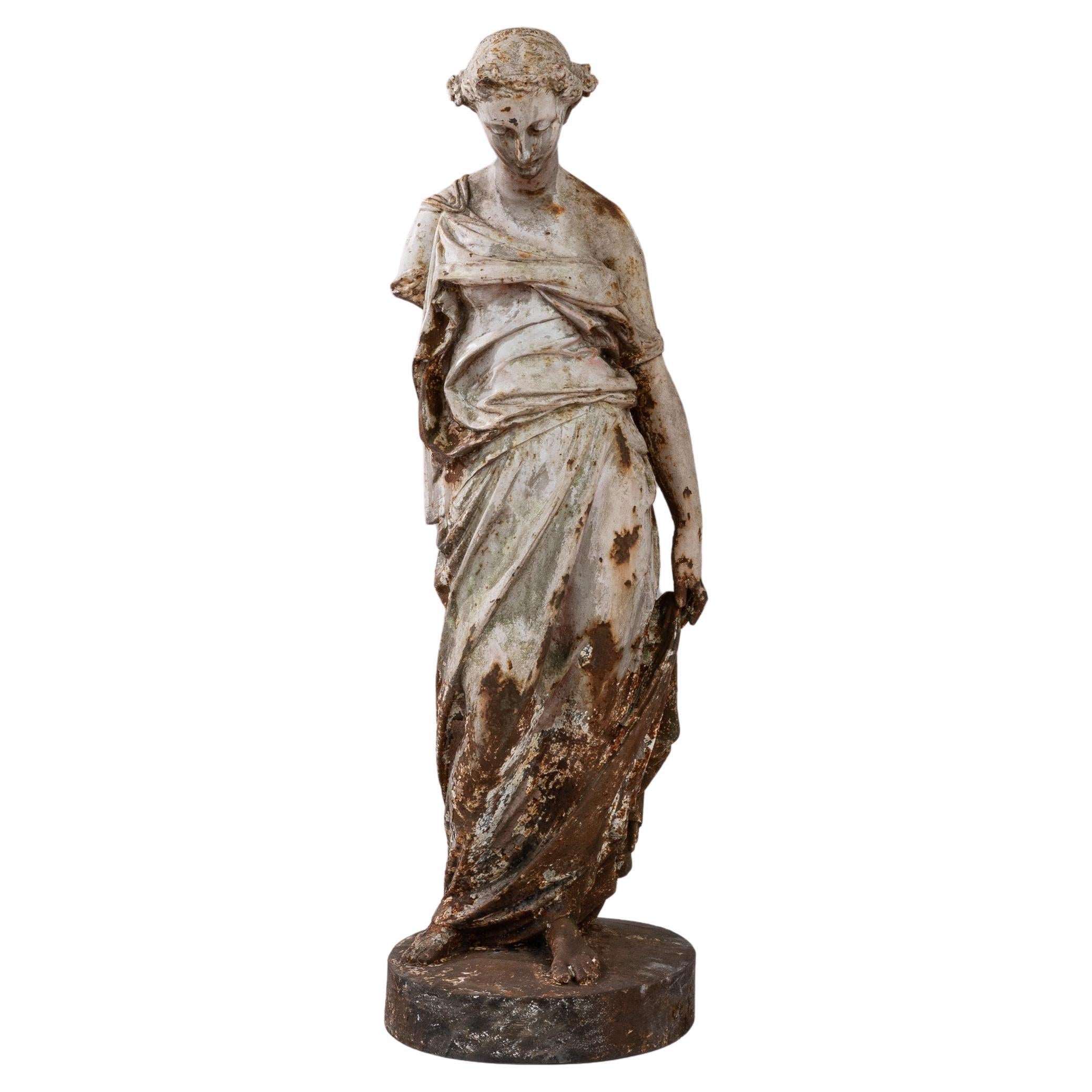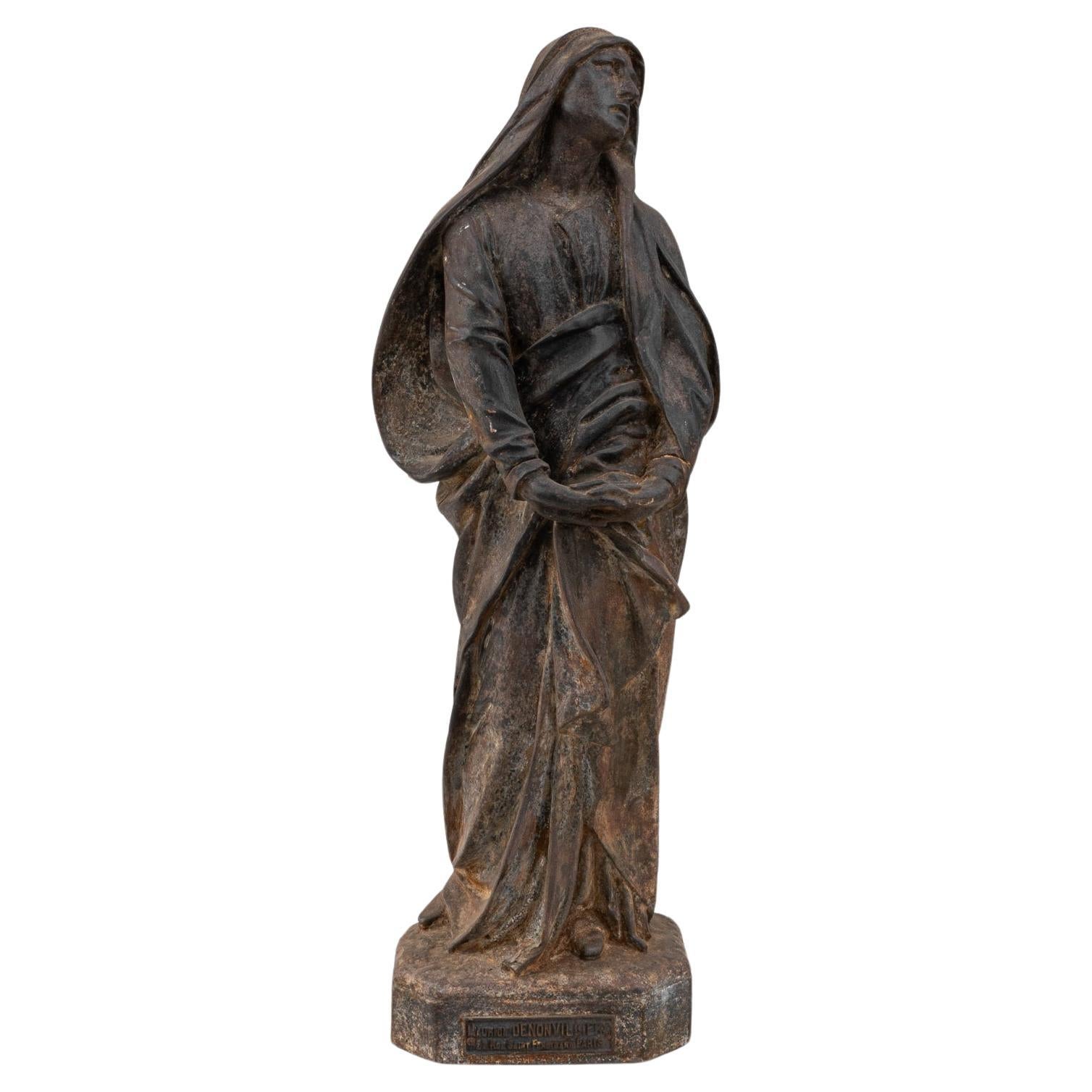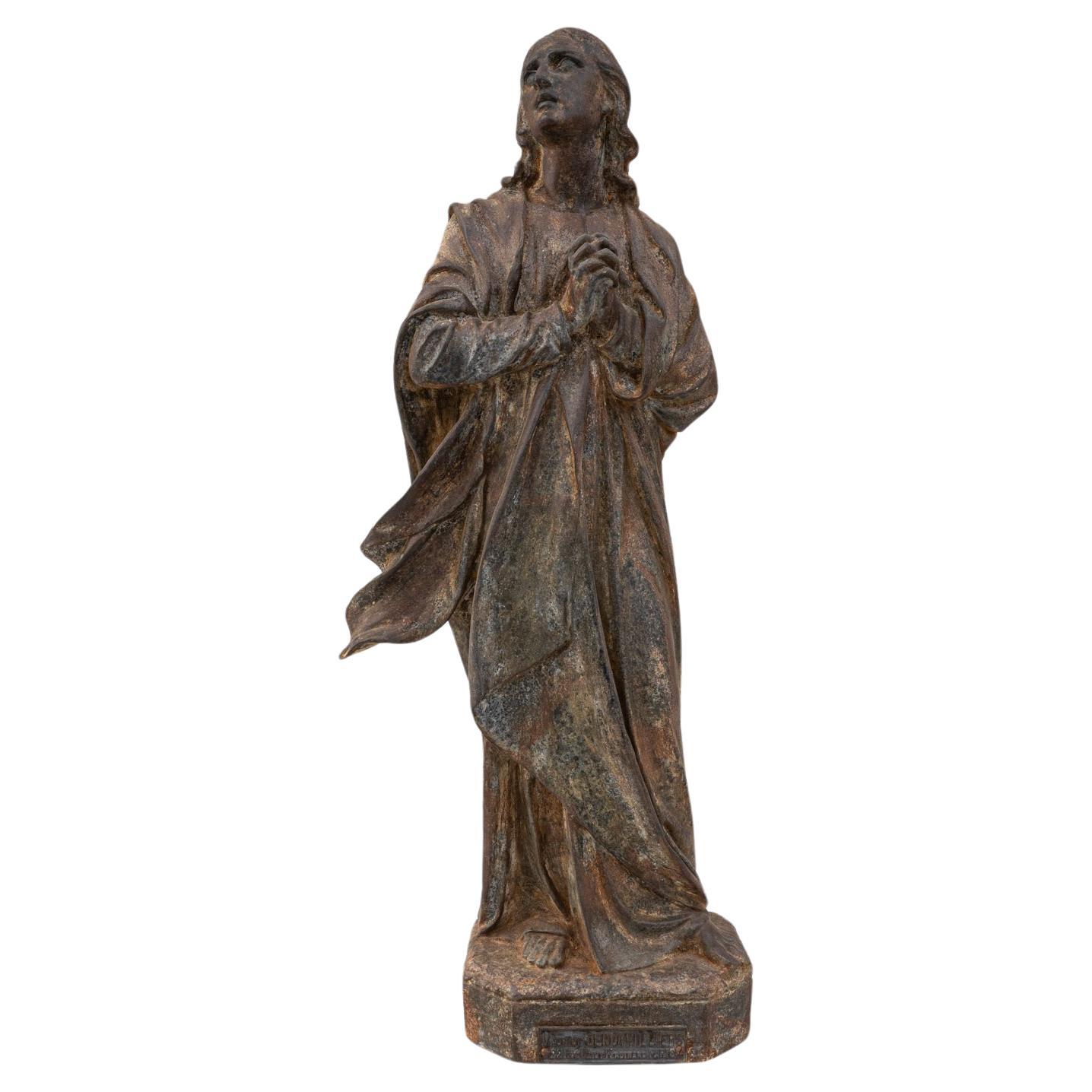Items Similar to Monumental French 19th Century Cast-Iron Bust of 'Head of Antinous as Dionysus'
Want more images or videos?
Request additional images or videos from the seller
1 of 21
Monumental French 19th Century Cast-Iron Bust of 'Head of Antinous as Dionysus'
About the Item
A Monumental French 19th Century Patinated and Parcel Gilt Cast-Iron Bust of 'Head from a Statue of Antinous as Dionysus' Wearing a Wreath of Ivy - Roman Bacchus, God of the Wine, after the Greek models of the mid-4th century BC. Bust. This monumental larger-than life bust, cast by the Parisian foundry 'J.J. DUCEL Me de FORGES, PARIS', is an exceptional example of artistic skills in copying antique forms and modernizing them by using cast-iron. Antinous was a handsome youth, a Greek from Bythinia. The favorite of the Roman Emperor Hadrian (117-138). The Emperor Hadrian became obsessed with Antinous, a young man from Asia Minor, to the extent that the Emperor created a cult of Antinous when the young man died, in 130 CE. He was tragically drowned in the Nile during a drip to Egypt with the Emperor in 130 CE. According to one version, he died saving the Emperor's life. After the death of Antinous, Hadrian ordered that he be deified. His statues, as the gods Dionysius or Hermes, adorned Hadrian's villa at Tivoli just outside Rome. The original portrait, currently at The State Hermitage Museum, St.Petersburg, was found during excavations at Tivoli in 1769. Antinous is shown as Dionysius, god of wine and merrymaking, his luxuriant locks of hair crowned with a branch of Italian pine. The young man's face is classically handsome and his idealized features recall a Greek statue of the Classical period. At the same time there are still traces of individual features, such as the thick brows over the small, close-set eyes. The expression of sadness is typical of many statues of Antinous, who died so young. In European art, the image of Antinous became synonymous with ideal male beauty. Cast-Signed "J.J. DUCEL Me de FORGES, PARIS". Circa: Paris, 1880-1890.
A retailer of fine cast-iron ornaments, J. J. Ducel was recorded as supplying cast-iron works through Paris as early as 1810 in the Pas-de-Calais. The factory was sold in 1878 to the Fonderie de la Haute-Marne and all of the firm's models were subsequently bought by the Val d'Osne foundry. However, prior to the firm's sale, critics at the 1867 Paris Exposition Universelle proclaimed that "Ducel is the great manufacturer of works in cast-iron, to whom Paris is so largely indebted for the grace and elegance that supply so many of the adornments of its streets". Ducel, Val d'Osne and other associated foundries produced both bronze and cast-iron statuary. Cast-iron is corrosive, whereas non-ferrous bronze does not suffer the same detrimental effects of weathering and is therefore a superior and more expensive material.
Height: 29 inches (73.7 cm)
Width: 15 inches (38.1 cm)
Depth: 18 inches (45.7 cm)
Base: 12 1/4 inches by 15 inches (31.2 cm x 38.1 cm).
- Dimensions:Height: 29 in (73.66 cm)Width: 15 in (38.1 cm)Depth: 18 in (45.72 cm)
- Style:Greco Roman (In the Style Of)
- Materials and Techniques:
- Place of Origin:
- Period:
- Date of Manufacture:circa: Paris, 1880-1890
- Condition:Additions or alterations made to the original: Patina. Refinished. Wear consistent with age and use. Minor fading. A truly stunning and large bust of the God Dionysus (Roman Bacchus), finely executed in cast iron with a dark brown patina and parcel gilt details. Overall condition is very good with patina wear and patina finish restoration. Please view all images.
- Seller Location:Los Angeles, CA
- Reference Number:
About the Seller
5.0
Vetted Seller
These experienced sellers undergo a comprehensive evaluation by our team of in-house experts.
Established in 1982
1stDibs seller since 2016
113 sales on 1stDibs
Typical response time: <1 hour
- ShippingRetrieving quote...Ships From: Los Angeles, CA
- Return PolicyThis item cannot be returned.
More From This SellerView All
- Pair of French 19th-20th Century Neoclassical Style Cast Iron Figural TorchèresLocated in Los Angeles, CAA very fine pair of French 19th-20th century neoclassical style patinated cast iron figural torchères by A. Durenne, Paris, each representing a figure of a standing young maiden, her arms raised forward while holding a a flaming urn gas light (Now electrified) with a frosted glass flame, each raised on a veined grey marble column stand, both cast-signed 'A. Durenne, Paris'. Antoine Durenne was an internationally renowned French art founder. He attended École Nationale Supérieure des Beaux-Arts in 1842. Durenne purchased a small foundry in Sommevoire, near the Val d'Osne, Haute-Marne, France and established The Durenne firm, circa Paris, 1900. Cast-iron had been in production during the 18th century but its inferior status to the more fashionable and delicate wrought iron had generally confined its use to architectural work. By the early 19th century, however, rapid developments of the Industrial Revolution combined with the simultaneous burgeoning of a new middle class provided the impetus for a dramatic Expansion in its application and in a short space of time a proliferation of iron foundries across Europe and America thrived on the production of everything from inkstands to railway stations. The use of cast-iron for garden ornament became particularly widespread at this time, as the possibilities for its mass-production at a fraction of the cost of bronze made it the material of choice for outdoor statuary...Category
Antique Early 1900s French Neoclassical Revival Figurative Sculptures
MaterialsMarble, Iron
- Large French 19th Century Cast-Iron Fountain Figure of a Seated Nude MaidenBy J.J. Ducel Me de Forges 1Located in Los Angeles, CAA Fine and Large French 19th Century Cast-Iron Fountain Figure Modeled as a Nude Maiden Seated on a Rocky Outcrop Holding a Cornucopia in Her Raised Right Hand, by J.J Ducel. Cast-Signed "J.J. DUCEL Me de FORGES, PARIS". Circa: Paris, 1880. A retailer of fine cast-iron ornaments, J. J. Ducel was recorded as supplying cast-iron works through Paris as early as 1810 in the Pas-de-Calais. The factory was sold in 1878 to the Fonderie de la Haute-Marne and all of the firm's models were subsequently bought by the Val d'Osne foundry. However, prior to the firm's sale, critics at the 1867 Paris Exposition Universelle proclaimed that "Ducel is the great manufacturer of works in cast-iron, to whom Paris is so largely indebted for the grace and elegance that supply so many of the adornments of its streets". Ducel, Val d'Osne and other associated foundries produced both bronze and cast-iron statuary. Cast-iron is corrosive, whereas non-ferrous bronze does not suffer the same detrimental effects of weathering and is therefore a superior and more expensive material. Height: 51 1/2 inches (130.8 cm) Width: 22 inches (55.9 cm) Depth: 30 inches (76.2 cm) The foundry of Val d'Osne became highly regarded for the varied nature and quality of its castings in the second half of the 19th century. Commonly known after 1870 as simply Val D'Osne, the company was originally founded by J.P.V. André in Val d'Osne 1835 and developed rapidly, absorbing smaller foundries in the Haute-Marne area east of Paris. The foundry contributed to the London International Exhibition of 1851, where a bronze fountain cast with classical figures attracted much attention. André also specialised in fancy castings and architectural fittings. His Paris adress was at 14 Rue Neuve, Menilmontant. In 1855 the Barbezat & Cie Foundry was born out of the André workshop. In 1867 Barbezat & Cie changed its name to Houille & Cie. Then, in 1870, it changed its name to Société Anonyme du Val d'Osne. With the change of name came the change of casting mark and adress: Fonderies d'Art du Val d'Osne, 58 Bd Voltaire, Paris or simply Val d'Osne. Cast-iron had been in production during the 18th century but its inferior status to the more fashionable and delicate wrought-iron had generally confined its use to architectural work. By the early 19th century, however, rapid developments of the Industrial Revolution combined with the simultaneous burgeoning of a new middle class provided the impetus for a dramatic expansion in its application and in a short space of time a proliferation of iron foundries across Europe and America thrived on the production of everything from inkstands to railway stations. The use of cast-iron for garden ornament became particularly widespread at this time, as the possibilities for its mass-production at a fraction of the cost of bronze made it the material of choice for indoor/outdoor statuary...Category
Antique 19th Century French Classical Greek Figurative Sculptures
MaterialsIron
- Lifesize Italian 19th Century Specimen Marble Bust of a Greco-Roman WarriorLocated in Los Angeles, CAA very fine and mpressive life-size Italian, early 20th century marble bust of a Greco Roman Warrior, probably Hercules, after the antique. The large beautifully carved and decorated...Category
Early 20th Century Italian Greco Roman Busts
MaterialsMarble, Agate, Lapis Lazuli
- Palatial French 19th-20th Century Allegorical Figural Cast Iron Group TorchereBy Val D'Osne FoundryLocated in Los Angeles, CAA very fine and palatial French 19th-20th century allegorical figural cast-iron group torchere - sculpture - fountain - representing spring and the harvest, probably cast by Le Fonderies d'Art du Val d'Osne. The charming four-putti sculpture with a front standing putto holding a pole amongst wheat stalks, another putto kneeling and collecting wheat, a third one wearing a hat and picking flowers for a wreath and the fourth kneeling putto holding a bird's nest, all below an elongated classical stem with a glass globe (Electrified), circa: Paris, 1900. Overall height: 84 inches (213.4 cm). Width: 29 1/2 inches (74.9 cm). Circular base diameter: 24 inches (61 inches). Cast-iron had been in production during the 18th century but its inferior status to the more fashionable and delicate wrought-iron had generally confined its use to architectural work. By the early 19th century, however, rapid developments of the Industrial Revolution combined with the simultaneous burgeoning of a new middle class provided the impetus for a dramatic expansion in its application and in a short space of time a proliferation of iron foundries across Europe and America thrived on the production of everything from inkstands to railway stations. The use of cast-iron for garden ornament became particularly widespread at this time, as the possibilities for its mass-production at a fraction of the cost of bronze made it the material of choice for outdoor statuary...Category
Antique Early 1900s French Rococo Figurative Sculptures
MaterialsIron
- Pair of French 19th Century Lifesize Cast-Iron Sculpture Torcheres, Val d'OsneBy Val D'Osne FoundryLocated in Los Angeles, CAA superb quality and palatial pair of French 19th century lifesize cast-iron sculptures - torcheres of Native American Indians titled "L’ Indienne" designed by Jules Salmson (French, 1823-1902) and Cast by Le Fonderies d'Art du Val d'Osne, each standing figure representing a Native American Indian male and a female scantily dressed in their native robes, one arm raised holding a light-torch with an opaline glass globe, both wearing earrings, seashell necklaces and arm-braces, raised on cylindrical cast-iron stand. Signed/cast on each pedestal: “VAL D’OSNE”. (Electrified). Paris, circa 1870-1880. Overall hHeight: 127 inches (322.6 cm) Pedestal height: 39 inches (99.1 cm) Indian man's width: 22 inches (55.9 cm) Indian man's depth: 26 3/4 inches (68 cm) Indian woman's width: 28 inches (71.1 cm) Indian woman's depth: 25 inches (63.5 cm) These fantastic and impressive pair of cast-iron sculptures, most likely representing Hiawatha and Minnehaha, were probably comissioned to Le Fonderies d'Art du Val d'Osne for export to the America's to decorate governmental buildings and parks which makes these pair a rare find and now available for a private collection. Iron sculptures were preferred over bronze for outdoor park and building decorations for their long lasting resistance to all types of weather conditions. An identical pair of sculptures, also by Val d' Osne, are currently exhibited at the National Garden of Congress in Santiago, Chile. View Pages No. 87, 88, 89. Another identical pair are also currently exhibited at The Musée de la Ville - Indian Museum "O Indio do Museo da Cidade" in Rio de Janeiro, Brazil. Another identical pair decorate the front of the Ópera Teatro Amazonas, Manaús, Brazil. A single figure of the female Indian...Category
Antique 19th Century French Tribal Figurative Sculptures
MaterialsIron
- French 19th-20th Century Art Nouveau Polychromed Terracotta Bust of "Crépuscule"By Salesio LugliLocated in Los Angeles, CAA fine French 19th-20th century Art Nouveau polychromed terracotta bust of "Crépuscule" (Twilight) After Henri Jacobs (Belgian, 1864-1935) version of Crépuscule, depicting a young ma...Category
Antique Early 1900s French Art Nouveau Busts
MaterialsTerracotta
You May Also Like
- 19th Century Statuary Marble Bust of the Braschi Antinous as Dionysus, SignedLocated in London, by appointment only19th century statuary marble bust of the Braschi Antinous as Dionysus, Signed Puge 19th century statuary marble bust of Antinous as Dionysus, Sig...Category
Antique Mid-19th Century Italian Grand Tour Busts
MaterialsStatuary Marble
- White Plaster Bust of a Male Head, France, 19th CenturyLocated in New York, NYFrench 19th century plaster bust of a male head. Excellent condition.Category
Antique 19th Century French Busts
MaterialsPlaster
- French Late 19th Century Wall-Mounted Statue of a Cast Iron Horse’s HeadLocated in West Palm Beach, FLA handsome French late 19th century wall mounted statue of a cast iron horse's head. The statue displays an oblong back plate and lovely intricate ...Category
Antique 19th Century French Animal Sculptures
MaterialsIron
- 19th Century French Cast Iron SculptureLocated in High Point, NCBehold the stately elegance of this 19th Century French Cast Iron Sculpture, a stunning representation of classic beauty and enduring craftsmanship. The sculpture, with its weathered...Category
Antique 19th Century French Figurative Sculptures
MaterialsIron
- 19th Century French Cast Iron SculptureLocated in High Point, NCThis evocative 19th Century French Cast Iron Sculpture captures the profound emotion and exquisite detail synonymous with the era's artistry. The figure, robed in beautifully sculpte...Category
Antique 19th Century French Figurative Sculptures
MaterialsIron
- 19th Century French Cast Iron SculptureLocated in High Point, NCThis 19th Century French Cast Iron Sculpture exudes the spirit of the Romantic era with its evocative depiction of a pensive figure. The artistry of the sculpture is evident in the e...Category
Antique 19th Century French Figurative Sculptures
MaterialsIron
Recently Viewed
View AllMore Ways To Browse
Dionysus Dionysus
French Cast Iron Base
Antique French Monumental
Roman Heads Furniture
Cast Iron Sign
Monumental Paris
Head Of Man Sculpture
Cast Iron Italy
Crown Man
4 Headed Italian
Bust Sold
Cast Iron Head
Italian Iron Sculpture Furniture
Monumental French Bronze
Antique Iron Works
Egypt Roman
Egyptian Roman
Classical Head Sculpture
